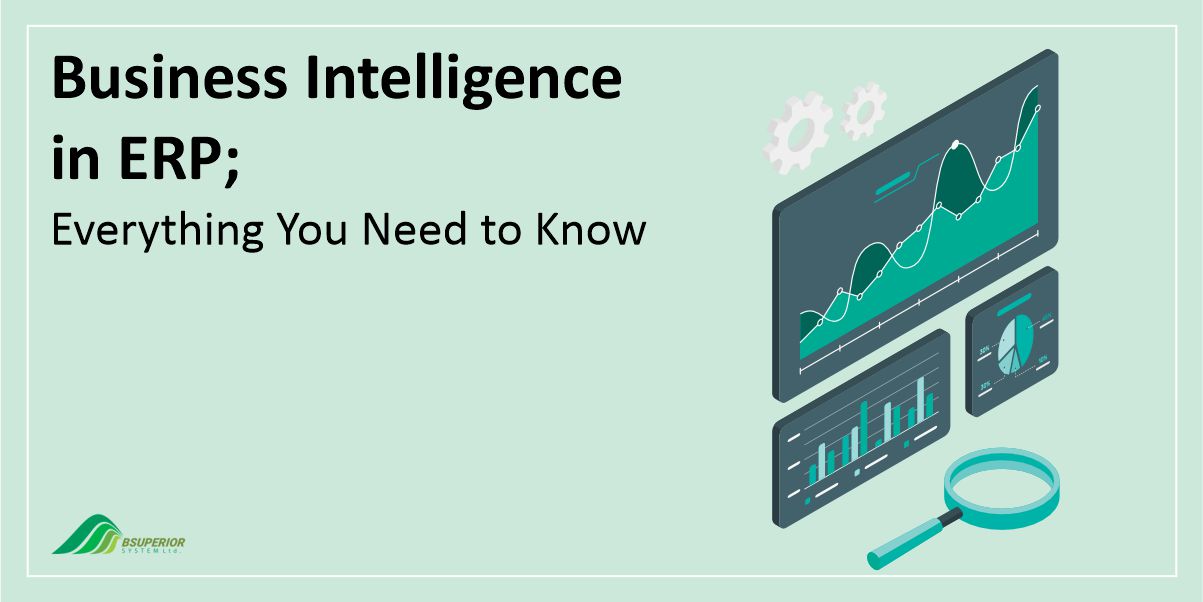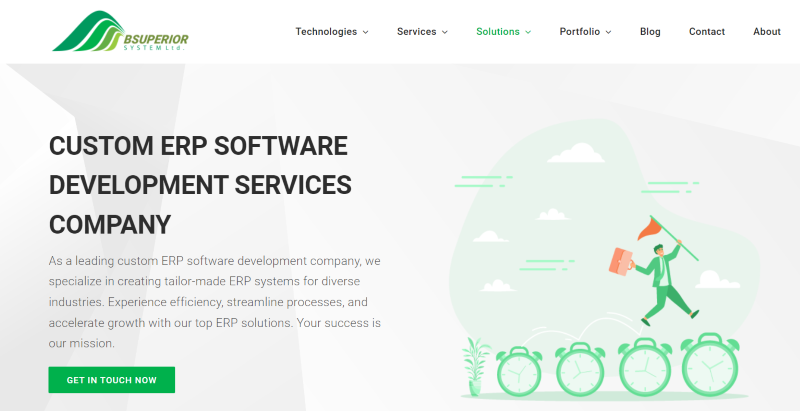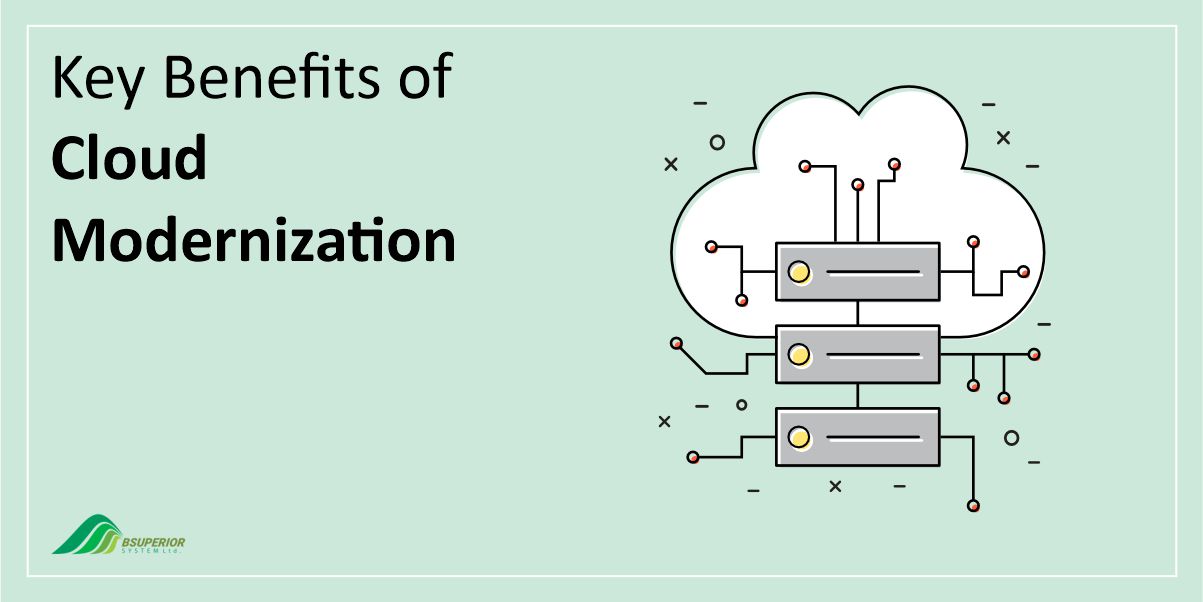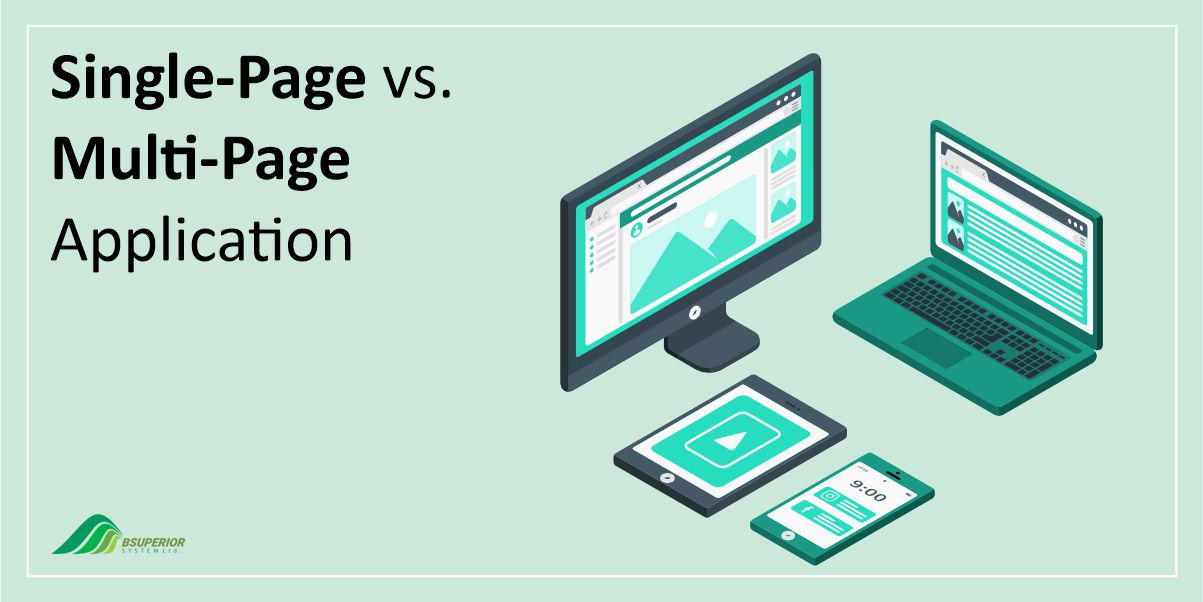Business Intelligence in ERP: Benefits, Example and Use Cases

Table Of Content
- What is Business Intelligence?
- What are the Main Concepts of BI?
- Real-Life Use Cases of BI
- ERP vs. BI: How Are They Distinguished?
- How BI and ERP Can be Integrated?
- Why is BI Important in ERP?
- Examples of ERP with BI
- BI and ERP Integration: The Challenges
- The Future of Business Intelligence in ERP: A Closer Embrace
- Bringing BI and ERP Together with BSUPERIOR
- Final Words
Businesses are constantly looking for innovative ways to gain an edge. One powerful alliance emerging in this regard is the integration of Business Intelligence (BI) with Enterprise Resource Planning (ERP) systems. In what follows, we’ll have a closer look at the practicality, benefits, and challenges of implementing BI within your ERP system.
What is Business Intelligence?
Business intelligence (BI) refers to a set of tools and technical infrastructure that helps businesses gather and analyze data from internal and external sources.
This information empowers leaders to make informed decisions across all levels, from strategic planning to addressing specific market demands. In simpler terms, BI can help businesses run smoother, identify strengths, and ultimately make more money.
In practice, BI pulls data from a central hub and uses it to create various tools like dashboards, reports, and customer-facing systems. This comprehensive view shows exactly where the business stands right now.
To put it another way, BI acts as a diagnostic tool for your business health which reveals what’s hidden within your business operations. If something’s wrong, like a supply chain problem, BI analysis can pinpoint the weak spot and suggest solutions.
Read More: 6 Top ERPs For the Pharmaceutical Industry
What are the Main Concepts of BI?
BI isn’t just about collecting data. It’s about turning that data into actionable insights that can help organizations thrive. Below are the core concepts that make this possible:
- Gather and Clean: BI starts by gathering data from various sources, such as internal systems, external platforms, and even spreadsheets. However, raw data is messy, so it needs to be cleaned, organized, and standardized before analysis.
- Analyze and Explore: Data analysts use tools and techniques to dig deep into the cleaned data, uncovering patterns, trends, and hidden connections. This may involve statistical methods or even machine learning algorithms.
- Visualize and Understand: Complex data can be overwhelming. BI uses visual tools like charts, graphs, and dashboards to present insights in a clear and understandable way, making it easier for everyone to grasp the information.
- Report and Monitor: BI involves regular reports and interactive dashboards that track key performance indicators (KPIs) and metrics. These reports offer a quick overview and allow users to drill down for deeper analysis.
- Support and Strategize: Eventually, BI is about supporting better decision-making. By aligning data analysis with business goals and objectives, organizations can identify opportunities, address challenges, and optimize their operations for success.
Real-Life Use Cases of BI
BI provides many companies around the world with a competitive advantage and helps them achieve their goals in a more efficient way. Let’s take a look at 3 use cases of the implementation of BI below.
Use Case 1: Cementos Argos
Cementos Argos is a multi-national cement company that provides a good example of how BI can be beneficial. The company was looking for a way to improve its overall competitive advantage and make better-informed decisions.
To achieve this goal, they decided to establish a dedicated business analytics center. They invested in building teams of experienced business analysts and data scientists. Additionally, the Cementos Argos company made use of BI tools to extract insights from their data.
As a result, Cementos Argos was able to standardize its financial processes and use big data analytics to gain a deeper understanding of customer behavior.
Use Case 2: Sabre Airline Solutions
Sabre Airline Solutions offers a suite of technologies including reservation tools, revenue optimization, and digital travel management solutions for the aviation sector, hospitality industry, and other travel-related businesses.
Given the rapid pace of the travel sector, Sabre’s customers required sophisticated tools capable of delivering instantaneous data regarding consumer trends and behaviors.
To manage its vast data repository, Sabre implemented an enterprise travel data warehouse (ETDW). The company’s executive dashboards facilitate almost immediate access to insights within an intuitive interface.
It provides a comprehensive view of the company’s financial status, booking activities, operational efficacy, and ticket sales.
The system’s expandable architecture, visual interface, consolidated data, and collaborative features have contributed to an increase in earnings and heightened customer satisfaction.
Use Case 3: Univision
Univision is a provider of Spanish-language content in the United States. The company wanted to improve the effectiveness of its advertising spend. The main challenge was obtaining better visibility into their data to support targeted advertising campaigns.
To deal with this, Univision implemented a BI solution that uses data from various sources, including Facebook, Google Analytics, and Adobe Analytics.
This integration with programmatic TV buying, which is a data-driven approach to ad placement, helped them optimize their advertising efforts.
Thanks to this, Univision reportedly experienced an 80% increase in advertising yield within the first quarter.
ERP vs. BI: How Are They Distinguished?
ERP and BI are like two puzzle pieces that fit together to create a complete picture of your business.
ERP functions as the backbone of your operations. It handles core processes like manufacturing, finance, and inventory, centralizing data and streamlining tasks. It’s all about efficiency and smooth day-to-day running.
BI, on the other hand, analyzes data from across the company and uncovers patterns and trends. You can consider it as the detective that helps you understand what your data is telling you.
It translates complex numbers into clear insights and dashboards, making it easy for everyone to see what’s happening.
With that being said, ERP and BI are different tools that share the same goal. ERP focuses on the here and now, giving you real-time snapshots of how your business functions. BI goes deeper and uses the data and more to identify long-term trends and refine strategies at all levels.
Read More: Best Food and Beverage ERP Solutions in 2024
How BI and ERP Can be Integrated?
By integrating BI and ERP systems, you will have a single, clear picture of your entire business operation. Let’s see how these two can be integrated:
- Data Integration: By connecting BI and ERP, you get a constant stream of fresh data. No more outdated reports or delays – your analysis is always based on the latest information, leading to more informed decisions.
- Reporting: BI tools go beyond basic ERP reports. They pull data directly from your ERP and by doing this enable you to create detailed and tailored reports that paint a precise picture of your operations.
- Data Analysis: BI tools are analysis powerhouses. They scan your ERP data for trends, patterns, and hidden connections. This helps you optimize operations, identify areas for improvement, and make smarter decisions based on real insights.
- Forecasting: BI tools can use your ERP data to create forecasts, helping you plan for future growth and anticipate potential challenges. This proactive approach gives you a competitive edge.
Why is BI Important in ERP?
To help you better understand why the integration of BI and ERP pays off, we’d better dig deeper into the specific advantages of such integration.
1. Metrics That Matter
BI lets you track critical metrics like sales, productivity, and customer satisfaction, all within your ERP system. This means no more juggling spreadsheets and fragmented data. You can easily identify areas for improvement and focus on what matters most.
2. Actionable Insights, Not Just Data
BI goes beyond raw numbers. It analyzes data to uncover hidden trends, patterns, and even anomalies that manual analysis might miss. Visualizations and reports present this information clearly, helping you spot opportunities and tackle challenges quickly.
3. Efficiency Boost
BI empowers employees with the information they need to work smarter and faster. It also pinpoints inefficiencies in your operations, allowing you to streamline processes and maximize productivity.
4. Happier Customers
BI helps you understand your customers better, their preferences, and their needs. This translates to improved customer service through better-targeted marketing, personalized experiences, and effective relationship management.
5. Smarter Staffing
BI and analytics in ERP help you make objective hiring and firing decisions based on employee performance data, not personal biases or office politics. This will contribute to a more effective and engaged workforce.
Read More: ERP Data Migration: The Essentials You Need to Know
Examples of ERP with BI
Several ERP solutions have incorporated BI features that help organizations obtain immediate data and insights about their operations, financial status, and customer patterns. These are a few instances in this regard:
- SAP ERP and SAP BusinessObjects: SAP, a prominent ERP solution provider, offers the SAP BusinessObjects suite, which includes complex analytics tools that complement their ERP offerings.
- Microsoft Dynamics 365 and Power BI: The widely-used ERP solution, Microsoft Dynamics 365, can be coupled with Power BI, Microsoft’s own analytics and business intelligence service.
- Oracle ERP Cloud and Oracle Analytics Cloud: Oracle delivers an ERP solution hosted in the cloud, which can be seamlessly integrated with the Oracle Analytics Cloud service.
BI and ERP Integration: The Challenges
While blending BI with your ERP system promises incredible benefits, there are several challenges to deal with before unlocking its full potential.
1. Alignment Avalanche
Imagine departments operating in silos, with different KPIs, reports, and workflows. Integrating BI without harmonizing these processes can be like building a house on shifting sand.
The solution? Collaborate across departments to create a unified approach, ensuring BI serves everyone’s needs and boosts overall productivity.
2. Data Deluge
BI thrives on a comprehensive view of your business, encompassing internal and external data sources. However, ensuring consistent integration across all these channels can be a challenge.
So what can be done in this case? The key is to prioritize data quality and consistency, which will lead to laying a solid foundation for accurate and meaningful insights.
3. Strategic Stumble
Don’t dive headfirst into BI without a plan. Develop a well-defined strategy that outlines changes to processes, operations, KPIs, and reporting mechanisms.
Also, keep in mind that user training is crucial to ensure everyone understands the upcoming changes and their roles in the new system.
4. Off-the-Shelf Blues
Generic BI solutions might look tempting, but they often fall short of meeting your specific business needs. This can lead to frustration, poor usability, and consequently, decreased profitability.
Instead, consider a custom ERP system (check the last part of this blog post) with integrated BI functionality. This ensures the software aligns seamlessly with your unique workflows and can adapt to your evolving needs.
The Future of Business Intelligence in ERP: A Closer Embrace
We all look forward to a future where BI and ERP are seamlessly integrated which enables organizations to make informed decisions at lightning speed. That’s certainly the exciting prospect that awaits as these two technologies continue to evolve.
This future isn’t just wishful thinking. It’s driven by the evolution of both technologies. Collaboration will be key, with ERP dissolving data silos between departments and BI creating a platform for shared knowledge and unified goals.
Think of it like this: ERP keeps companies on top of their data and operations, but it’s like having a mountain of raw materials. BI steps in with its analytical muscles, consolidating and interpreting that data into actionable insights, the finished product your business needs to thrive.
An integrated ERP-BI solution becomes the single source of truth that provides real-time data to everyone and allows for benefits including:
- Trendspotting: See changes before they hit, proactively adjusting strategies for a competitive edge.
- Enhanced Reporting: Uncover deeper insights from larger data sets, painting a clearer picture of your business health.
- Faster, Informed Decisions: No more waiting for reports. Make data-driven choices in real-time.
- Improved Oversight: Gain a holistic view of your operations, ensuring informed decision-making across all levels.
With this powerful duo, organizations won’t just survive. They’ll thrive in a competitive landscape, armed with the intelligence and foresight to make winning moves.
Bringing BI and ERP Together with BSUPERIOR
All this discussion of the integration of BI and ERP brings us to the final point of this blog post. How do you want to implement this BI-ERP integration and start reaping the benefits? We have just the right answer for you – BSUPERIOR.

At BSUPERIOR, we’re not just spectators in this evolution. We’re here to guide your journey. As a leading custom ERP software development company, we don’t build off-the-shelf solutions. Rather, we specialize in developing tailor-made ERP systems that perfectly fit the unique needs and complexities of your industry.
But it doesn’t stop there. Our integrated Business Intelligence and Reporting Module goes beyond data storage. It provides you with powerful tools to analyze, interpret, and visualize complex datasets in intuitive dashboards.
BSUPERIOR is your partner in this journey to the future. We’ll help you seamlessly integrate BI and ERP, unlock the hidden potential within your data, and empower your organization to thrive in a competitive landscape. Let our experienced software development team guide you through integrating BI into your ERP system.
Ready to take the first step? Contact BSUPERIOR today and let’s discuss how we can navigate you through integrating BI into your ERP system.
Final Words
To sum up, it is clear that both ERP and BI are valuable tools, each with its own strengths. Together, they help you manage operations efficiently, identify areas for improvement, and drive better results.
Whether you’re evaluating marketing campaigns or tracking inventory costs, BI can help you make data-driven decisions and save time and resources.
Don’t forget though that, as we mentioned above, integrating BI with ERP isn’t without its hurdles. Understanding these challenges is crucial to maximizing the potential of this powerful combination and paving your path to data-driven success.
We value your input and believe this content may enhance our services. However, it's under review. If you see room for improvement, please use the "Report an issue" button below. Your feedback helps us excel.
Contact us today at –– and speak with our specialist.




